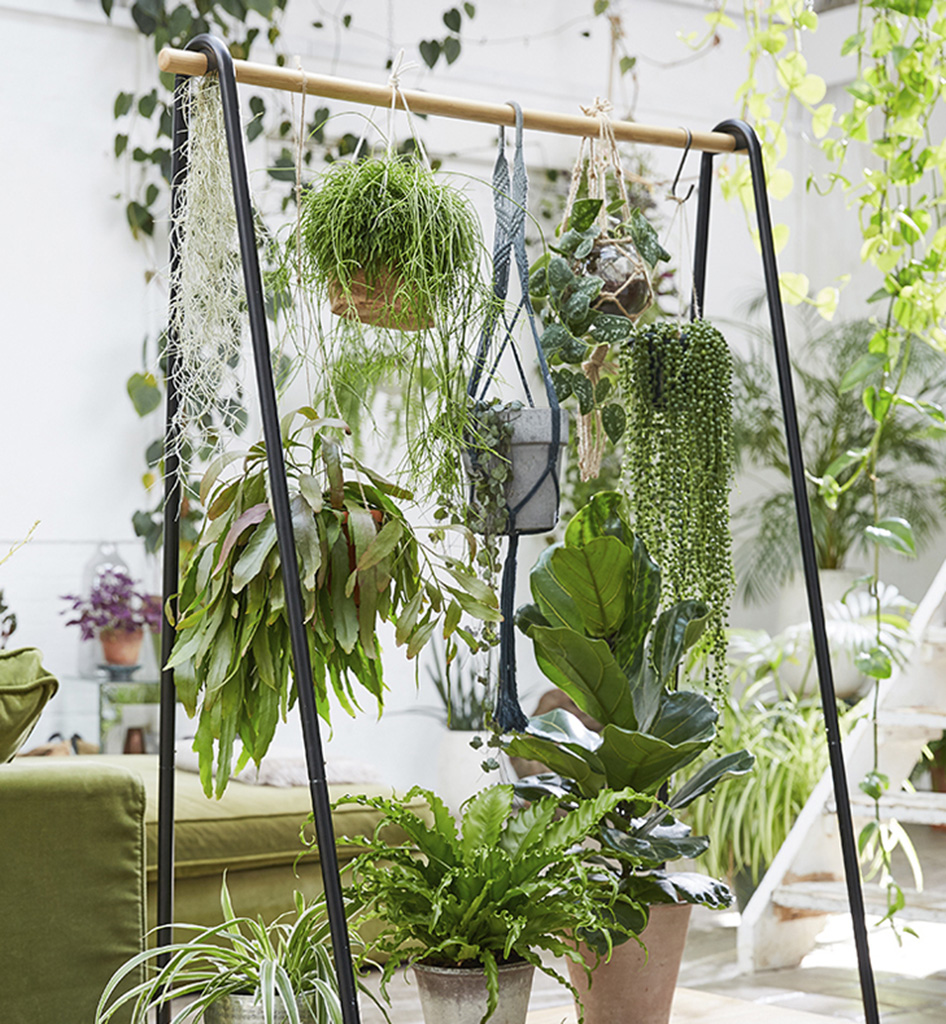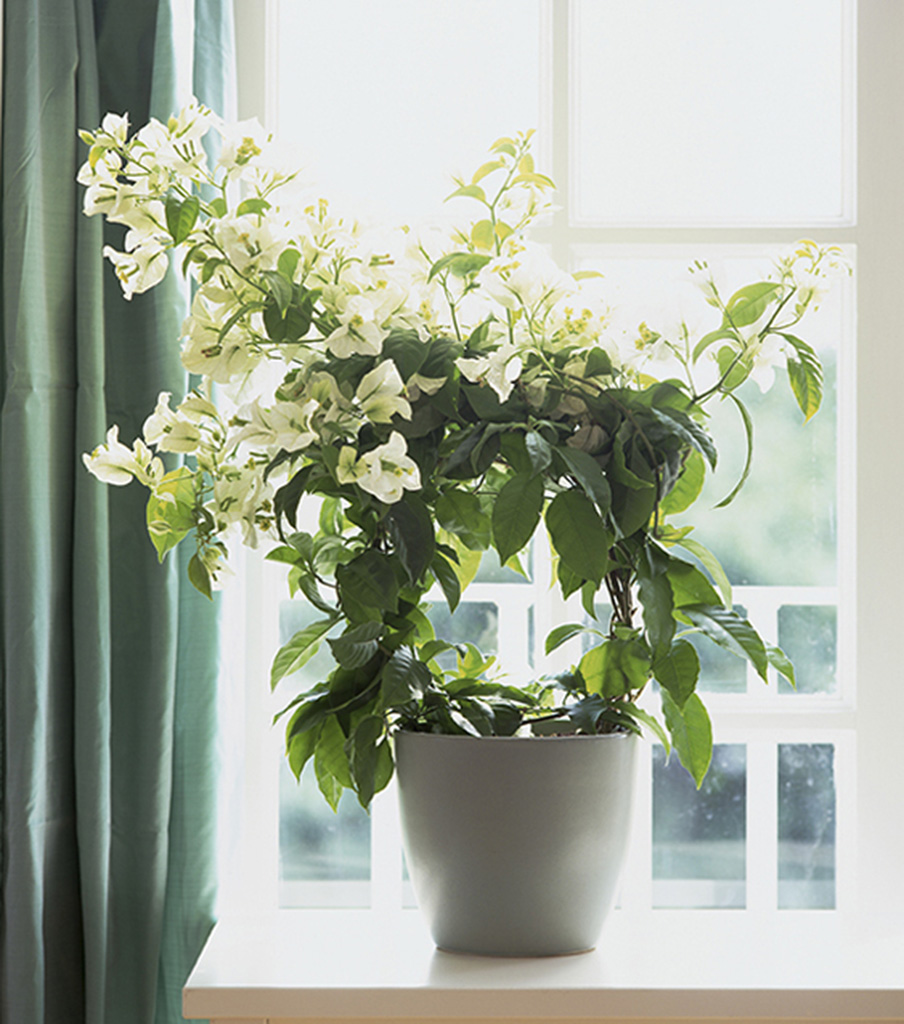DISPLAYING TRAILING AND CLIMBING PLANTS
Plants that clamber up supports or cascade magnificently from balconies or baskets add a huge amount of drama and spectacle to a room. This makes them great value plants and ideal for those who are short on floor or surface space. Decide how your plants are to be supported and trained and they’ll be easy to control and sculpt to suit the exact requirements of the space.

Trailing plants allow you to fill a room with floor-to-ceiling greenery—a great way to inject vertical interest and color.
HANGING BASKETS
Trailing plants introduce elegance and a different dimension to displays. There’s a wide range to choose from, including the ever-popular spider plant and the silver inch plant.
For those who are short on space, displaying in hanging baskets means you’re able to fill an entire room with plants. There’s a wealth of hanging containers available, from ceramic, wicker, and plastic to macramé and metal. Most are designed for a plant pot to be dropped into them, but if you’re planning to plant directly into a hanging basket, make sure it’s watertight. Choose a style that will suit your interior and be large enough for your chosen plant.
Large, heavy baskets must be hung with care. Seek the advice of a DIY expert before drilling holes in ceilings, as some larger baskets will need to be hung from a joist. If you’re not permitted to drill into ceilings, you can hang lighter baskets from clothes racks, banisters, hat stands, shelving, coat hooks or even curtain rods.
Watering baskets can be a challenge, so invest in a stepladder and a watering can with a long spout.

A hanging display will weigh more when watered, so always make sure its support is adequate.

The style of your hanging basket can often add as much interest as the plant itself, so choose wisely.
TOP TIP WHEN CREATING A MIXED PLANTER, PLACE YOUR TRAILING PLANTS AROUND THE INSIDE EDGE OF THE POT TO ENCOURAGE THEM TO TUMBLE OVER THE SIDE. THIS WILL NOT ONLY SOFTEN THE DISPLAY, BUT MAY ALSO HELP TO DISGUISE AN UNATTRACTIVE CONTAINER.
MOSS POLES
In their native environment, large plants with aerial roots, such as the Swiss cheese plant, naturally use other plants as a frame to grow against. They don’t have suckers to pull themselves up a support, but their aerial roots will hook onto a moist support and hold the plant upright. In a room setting, without help of this kind, plants become too sprawling for the available space and branches may be damaged under the weight of their own foliage.
To resolve this issue, some climbers and plants with aerial roots are trained up moss poles, which mimic the moist trunk of a jungle tree. These poles are widely available and can be bought precut in different heights. Simply push the pole into the plant pot and then use wire or string to attach the plant to the support. Keep the moss pole moist with regular misting. Over time, the aerial roots will gradually hook themselves onto it. You can easily prune excessive growth to keep the plant the same height as the chosen moss pole.

Without a support, a Swiss cheese plant will outgrow its space.
LIVING SCREENS AND WALL COVERINGS
Climbers are a great way of covering a wall or creating a living screen in a room. Galvanized wires attached to a wall are the most inconspicuous supports available. Plants that have suckers, such as ivy, will mark some walls, but you can avoid this by training them up freestanding supports. Trellis panels set away from a wall are a popular choice. When securely attached to the back of a long trough, they make the perfect room divider.
Tie climbers to a support to get them started, but as they mature, most will make their own way up it.
The biggest challenge comes in repotting. A plant that grows up a wall or trellis will be hard to remove from a pot after a few years. Instead of repotting, it’s best to grow it in a large pot and then, each year, remove some potting mix and replace it with a fresh layer.

Place climbing plants in large pots if you’re growing them up walls. You can fix inconspicuous wires to the wall to help them clamber up.
TRAINING OVER HOOPS
Not everyone has the space for climbers to leap up walls and trellises. You can keep climbing and trailing plants confined to one easily movable pot by simply winding their stems around a hoop or tripod. Many plants will already be trained over a hoop when you buy them.
Lightly prune the plant throughout the year to keep it to the shape of the hoop. Be careful not to remove all the growth that will hold flowers.
Plants that respond well to this very straightforward form of training include the paperflower and stephanotis.

The paperflower will remain a compact plant if trained appropriately.
